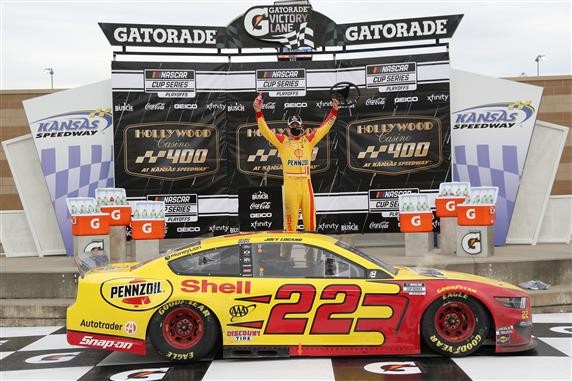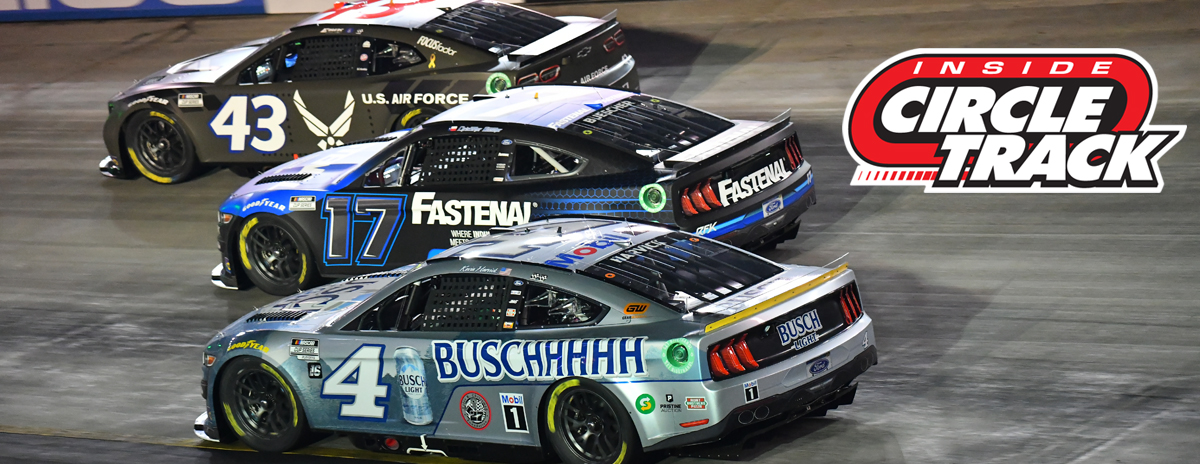
Joey Logano might not have had the best car but he ended his day in victory lane(Photo: Getty Images)
Whether it be from fans, media, or from the competitors themselves, there has been no shortage of opinion regarding the aerodynamic package put in place by NASCAR a couple of seasons ago for its top series. Often maligned, the combination that calls for lowered horsepower and higher downforce on the Cup Series cars was originally designed to manufacture closer competition, particularly on the tracks measuring 1.5 to 2 miles in length.
Criticism often centers around the fact that the measures such as larger spoilers and front splitters cause the cars to be firmly stuck in the turns while the lowered horsepower tends to reduce straightaway speeds. That combination essentially creates a situation in which drivers find themselves driving around the so-called “cookie cutter” facilities with their right foot planted on the floorboard for entire laps at a time, especially when on newer tires.
As we have seen in the recent races at Las Vegas Motor Speedway and Kansas Speedway, the leading driver can make himself very hard to pass if he so desires. A car that might not have been the fastest throughout the day but finds itself at the front of the pack due to pit strategy or fortunate timing in terms of cautions can hold the lead for an extended period of time, perhaps even all the way to the checkered flag, if trailing drivers do not wish to be overly aggressive.
Kurt Busch had not really demonstrated the ability to lead races for long stretches all season but after taking the lead of the race on a lap 243 restart in Las Vegas, the No. 1 Chip Ganassi Racing Chevrolet remained out front over the final 26 laps to score the win on that driver’s home track. It was Busch’s first win of the season and guaranteed him a spot in the ‘Round of 8’ portion of the NASCAR Playoffs.
This past Sunday, a very similar scenario to that in Las Vegas played out in Kansas.
Joey Logano was largely a 5th-10th place car for much of the day on the 1.5-mile layout. However, a good final pit stop gave him the highly coveted track position for the ensuing restart. The No. 22 Team Penske Ford got to the lead when the green flag waved then held off the advances of Kevin Harvick for the next 45 laps. Harvick seemingly had the best car throughout the day as was demonstrated by the fact that he led more laps(85) than any other competitor. However, he was never able to make a strong enough run on Logano to grab the lead.
NBC commentators and former driver and crew chief Dale Earnhardt, Jr. and Steve Letarte described the aerodynamics at play as being somewhat like having a beach ball wedged between the lead car and the second-place machine. According to their explanation, the trailing car stirs a current of air in front of it which then pushes the lead car even without the two cars ever having to touch. As a result, the trailing car only helps to speed the lead car up as it closes in so that all the leader has to do is block the line of the trailing car and use that air bubble to its advantage.
This leads to a situation somewhat like watching go-karts fixed with power-robbing governors race around one of the touristy tracks in Pigeon Forge, Tenn. But here’s the thing, that is the very circumstance this low horsepower/high downforce package was supposed to create.
In previous years, fans often complained when the faster car would get out front and drive away to a big lead then cruise to the finish. Had Harvick been able to get by Logano on that final restart, that’s exactly what would have happened.
Because people claimed that those runaway races were boring, NASCAR’s previous leadership decided that every race should look like a restrictor plate affair with cars essentially running the same speed in large packs. Over the final laps in Kansas, that’s basically what occurred.
This may not be the popular opinion, but to be honest, watching the closing laps in Las Vegas and Kansas play out with a leader holding off a faster car was preferable to me over watching the lead car drive off into the sunset and cruise to a 4-5 second win. Don’t get me wrong, I would much rather see cars swapping positions and cross the finish line side-by-side after exchanging the lead several times over the final laps, but that isn’t really an option with this or any other package NASCAR has tried in recent years.
While it may have seemed frustrating to some watching the race-ending laps in Kansas, it was also somewhat tension-filled. Harvick could have pressed the issue a bit more but his security in the current standings probably lead him to play it a little less aggressively that in other situations.
So like it or not, at least it was a close finish.
Richard Allen is a member of the National Motorsports Press Association
Respond to this piece on Twitter –> @RichardAllenIDR
or on Facebook –> InsideCircleTrack/Facebook
